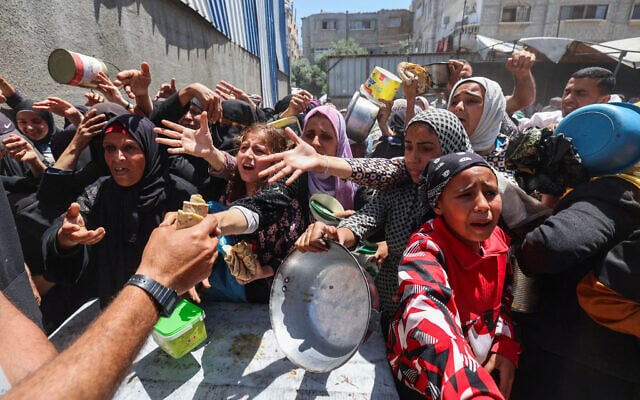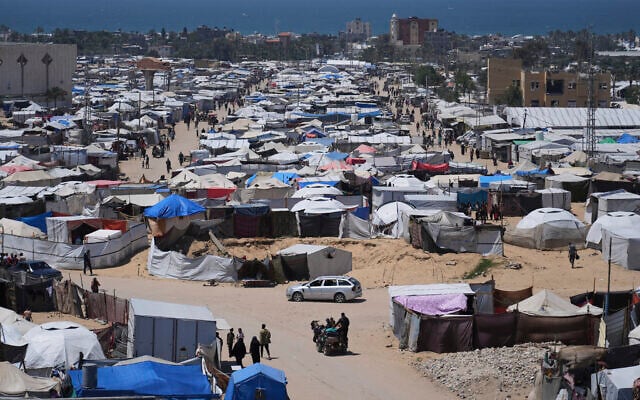



The Trump administration is pressuring international humanitarian organizations to cooperate with Israel’s new plan to resume the distribution of aid in the Gaza Strip after an over two-month IDF blockade, three sources familiar with the matter told The Times of Israel this week.
Organizations briefed on the initiative have expressed heavy skepticism, arguing that it fails to adequately address the humanitarian crisis in the war-ravaged enclave and requires them to be complicit in the “weaponization” of aid by Israel.
Amid this pushback, the Trump administration has indicated to these organizations — including the World Food Program — that their US funding could be slashed if they do not cooperate, a staffer at an international aid group, a senior Western diplomat and an Israeli official told The Times of Israel.
As part of its effort to bring WFP on board, the Western diplomat said that US officials held a meeting earlier this week with the organization’s executive director Cindy McCain along with representatives from the Gaza Humanitarian Foundation (GHF), which was established in January in order to advance a new solution for the distribution of aid that prevents it from being diverted by Hamas and other terror groups.
Asked for comment on the matter, a State Department spokesperson did not deny that pressure is being applied to international organizations.
“While we don’t have anything to announce and wouldn’t speak on behalf of the foundation, we welcome moves to quickly get urgent food aid into Gaza in a way that prevents it from falling into the hands of terrorists. We have long called for creative solutions and new thinking that leaves Israel secure and helps the people of Gaza,” the spokesperson said.
The State Department spokesperson went on to reference US President Donald Trump’s comments from earlier this week in which he asserted, “We are going to help the people of Gaza because they are being treated very badly by Hamas.”
“Trump had said, ‘We’re taking care of it’ weeks ago, and he meant it,” the spokesperson said.
The World Food Program did not respond to requests for comment.
GHF is still trying to secure funding from various governments for the initiative, and while there had been hope that the United Arab Emirates would be among the top backers, two sources familiar with the matter said Abu Dhabi has yet to make such a commitment due to its concerns over the plan’s viability.
Nonetheless, GHF is still planning to publicly unveil the initiative later this week, the Israeli official told The Times of Israel. State Department spokesperson Tammy Bruce appeared to reference that announcement during a Tuesday briefing when she told reporters, “An important announcement regarding the entry of aid to Gaza will be issued in the next few days, and there is very good news.”
Trump himself indicated Wednesday that there would be a Gaza-related announcement in the next 24 hours.
Israel is not waiting, though, and the IDF has already begun building the first of several humanitarian hubs in southern Gaza from which it plans to distribute aid to civilians in the coming weeks, with the Israeli official acknowledging that some Gazans “are on the brink of starvation.”
Those hubs are being paid for by Israel, but Jerusalem is aiming for other parts of the project to be funded by foreign governments and international organizations.
The Israeli official expressed optimism that some organizations will get on board with the plan, though the organizations currently involved in the Gaza humanitarian operation issued a joint statement earlier this week asserting that they will not cooperate after being briefed by Jerusalem on what it has planned.
The Israeli initiative will create a new humanitarian zone between the Philadelphi Corridor along Gaza’s southern border with Egypt and the newly established Morag corridor roughly five kilometers north. The area largely constitutes the southern Gaza city of Rafah. Those entering the corridor will pass through army checkpoints in what the IDF hopes will prevent Hamas fighters from reaching the area.
The Israeli official said that the humanitarian zone — while making up roughly ten percent of the Strip — is large enough to house Gaza’s entire population of roughly 2 million people, though Jerusalem is also hoping some of them will be able to leave the Strip.
Thus far, however, no countries have come forward offering to take in Gazan refugees, with Israel refusing to publicly commit to allowing those who leave to return. Some senior members of Prime Minister Benjamin Netanyahu’s coalition say the government’s plan to to permanently reoccupy the territory and establish settlements there.
In the meantime, ministers approved on Sunday the establishment of the new humanitarian mechanism to be managed by GHF.
None of the four individuals listed on GHF’s registration form in Switzerland have backgrounds in humanitarian relief, but the foundation is working to recruit experts in the field to serve on its advisory board, the Western diplomat said.
The mechanism envisions private American security contractors securing the aid hubs, which will be located within the humanitarian zone but far away from the tent encampments where civilians are expected to shelter. Five to six thousand vetted representatives will be allowed to travel by foot to the aid hubs once every two weeks in order to pick up a roughly 40-pound box of food for their families, said officials briefed on the plan.
The international aid group staffer said the plan does not take into account the current reality in the Strip, where hungry Gazans desperate for food are likely to flood the aid hubs once they are opened.
The staffer also took issue with the mechanism’s plan to only facilitate the entry of 60 trucks into Gaza each day from one crossing, saying the amount does not come close to what will be needed to feed the already-malnourished Gazan population.
The Israeli official insisted that the 60-truck figure will be sufficient to prevent starvation of Gazans.



